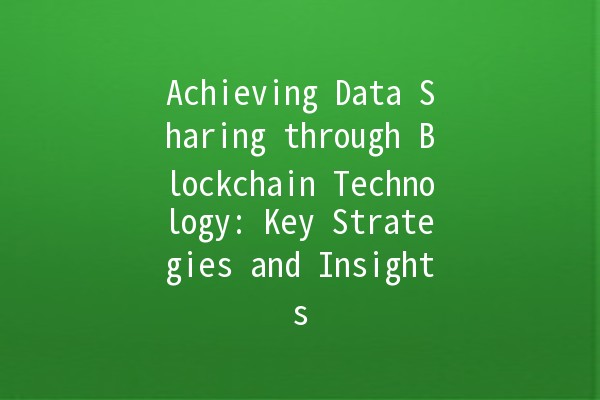




In an increasingly interconnected world, data sharing has become vital for businesses, governments, and individuals alike. Traditional methods of data sharing often involve cumbersome infrastructure and have raised significant concerns regarding privacy, security, and trust. Enter blockchain technology: a decentralized, transparent, and secure method for sharing data. This article delves into how blockchain can facilitate data sharing, offering practical tips and insights to harness its capabilities effectively.
Blockchain is a distributed ledger technology that allows data to be stored across multiple computers in a way that ensures security, transparency, and immutability. Each piece of data, or "block," is linked to a chain of previous blocks, creating a chronological record that makes tampering nearly impossible. This unique structure facilitates secure data sharing across various parties without the need for a central authority.
Practical Tip: Utilize encryption in blockchain applications.

Encryption is essential for protecting sensitive data shared on blockchain networks. By encrypting data before it is added to the blockchain, stakeholders can ensure that only authorized parties can access the information.
Example Application: In healthcare, patient records can be stored on a blockchain with encrypted access, allowing medical professionals to share necessary information without compromising patient privacy.
Practical Tip: Implement smart contracts to automate processes.
Smart contracts are selfexecuting contracts with the terms of the agreement written directly into the code. They automatically execute actions when predetermined conditions are met, enhancing transparency and reducing the need for intermediaries.
Example Application: In supply chain management, blockchain can be used to track products from origin to delivery. Each step in the supply chain can be logged on the blockchain, providing realtime information about product status and authenticity.
Practical Tip: Use standardized protocols for blockchain platforms.
Interoperability is crucial for effective data sharing between different blockchain networks. By adopting standardized protocols, organizations can facilitate smooth communication and data transfer across disparate blockchain systems.
Example Application: Various industries can benefit from interoperable blockchains, allowing for seamless data sharing between sectors such as finance, healthcare, and logistics. This can enhance collaborative efforts on common projects, such as city planning or public health initiatives.
Practical Tip: Foster a community of users on the blockchain.
Creating a community of users who actively participate in maintaining the blockchain can help build trust among stakeholders. Consensus mechanisms such as proof of stake or proof of work ensure that multiple parties validate transactions, reducing the risk of fraud.
Example Application: In a peertopeer lending platform, blockchain can ensure that all transactions are visible and verifiable by all parties involved, which enhances trust and encourages more users to participate in the process.
Practical Tip: Leverage data analytics for informed decisionmaking.
With blockchain's immutable records, businesses can use data analytics to extract valuable insights from shared datasets. This can optimize processes, enhance customer experiences, and inform strategic decisions.
Example Application: Retailers can analyze customer purchasing trends from blockchainstored data to refine inventory management practices, improving response times to market changes and customer preferences.
Blockchain technology is a decentralized, distributed ledger system that securely records transactions across multiple computers. Each transaction is stored in a block, which is linked to previous blocks, creating a secure and tamperproof chain of information. This enables data sharing by allowing multiple parties to access and verify information without relying on a central authority, thereby enhancing trust and transparency.
Yes, blockchain can significantly enhance data privacy through encryption and controlled access. Sensitive data can be encrypted before being added to the blockchain, ensuring that only authorized users can decrypt and view the information. Additionally, blockchain's decentralized nature reduces the risk of data breaches associated with centralized databases.
While blockchain offers numerous benefits, challenges include scalability, regulatory compliance, and integration with existing systems. As blockchain networks grow, maintaining fast transaction speeds and efficiency can be difficult. Additionally, organizations must navigate varying regulatory frameworks, especially concerning data privacy laws.
Organizations can enhance blockchain security by following best practices such as implementing robust encryption techniques, regularly updating their software, conducting security audits, and ensuring that all users follow strict access control protocols. These steps help mitigate vulnerabilities and protect against unauthorized access.
While blockchain is a powerful tool for many datasharing scenarios, it may not be suitable for all cases. It is most effective for situations requiring high security, transparency, and trust among multiple parties. Organizations should assess their specific needs and determine if blockchain aligns with their datasharing requirements.
Businesses can begin adopting blockchain by identifying specific use cases for data sharing within their operations. They should then explore partnerships with blockchain technology firms to develop tailored solutions, ensuring proper training for staff and establishing governance structures to manage the blockchain effectively.
Through the strategic application of blockchain technology, organizations can revolutionize their datasharing practices. By enhancing security, promoting transparency, ensuring interoperability, and fostering trust, blockchain serves as a powerful tool that can enhance productivity and innovation in the digital age. The future of data sharing is not just innovative; it is decentralized and collaborative. As organizations continue to explore blockchain's potential, they will find new ways to leverage data for growth, efficiency, and competitive advantage.